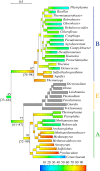The molecular signal for the adaptation to cold temperature during early life on Earth
- PMID: 24046876
- PMCID: PMC3971708
- DOI: 10.1098/rsbl.2013.0608
The molecular signal for the adaptation to cold temperature during early life on Earth
Abstract
Several lines of evidence such as the basal location of thermophilic lineages in large-scale phylogenetic trees and the ancestral sequence reconstruction of single enzymes or large protein concatenations support the conclusion that the ancestors of the bacterial and archaeal domains were thermophilic organisms which were adapted to hot environments during the early stages of the Earth. A parsimonious reasoning would therefore suggest that the last universal common ancestor (LUCA) was also thermophilic. Various authors have used branch-wise non-homogeneous evolutionary models that better capture the variation of molecular compositions among lineages to accurately reconstruct the ancestral G + C contents of ribosomal RNAs and the ancestral amino acid composition of highly conserved proteins. They confirmed the thermophilic nature of the ancestors of Bacteria and Archaea but concluded that LUCA, their last common ancestor, was a mesophilic organism having a moderate optimal growth temperature. In this letter, we investigate the unknown nature of the phylogenetic signal that informs ancestral sequence reconstruction to support this non-parsimonious scenario. We find that rate variation across sites of molecular sequences provides information at different time scales by recording the oldest adaptation to temperature in slow-evolving regions and subsequent adaptations in fast-evolving ones.
Figures


Similar articles
-
Adaptation to environmental temperature is a major determinant of molecular evolutionary rates in archaea.Mol Biol Evol. 2011 Sep;28(9):2661-74. doi: 10.1093/molbev/msr098. Epub 2011 Apr 15. Mol Biol Evol. 2011. PMID: 21498602
-
Parallel adaptations to high temperatures in the Archaean eon.Nature. 2008 Dec 18;456(7224):942-5. doi: 10.1038/nature07393. Epub 2008 Nov 26. Nature. 2008. PMID: 19037246
-
The universal ancestor and the ancestor of bacteria were hyperthermophiles.J Mol Evol. 2003 Dec;57(6):721-30. doi: 10.1007/s00239-003-2522-6. J Mol Evol. 2003. PMID: 14745541
-
Characterization of Reconstructed Ancestral Proteins Suggests a Change in Temperature of the Ancient Biosphere.Life (Basel). 2017 Aug 6;7(3):33. doi: 10.3390/life7030033. Life (Basel). 2017. PMID: 28783077 Free PMC article. Review.
-
The last universal common ancestor: emergence, constitution and genetic legacy of an elusive forerunner.Biol Direct. 2008 Jul 9;3:29. doi: 10.1186/1745-6150-3-29. Biol Direct. 2008. PMID: 18613974 Free PMC article. Review.
Cited by
-
Metagenomic Discovery of "Candidatus Parvarchaeales"-Related Lineages Sheds Light on Adaptation and Diversification from Neutral-Thermal to Acidic-Mesothermal Environments.mSystems. 2023 Apr 27;8(2):e0125222. doi: 10.1128/msystems.01252-22. Epub 2023 Mar 21. mSystems. 2023. PMID: 36943058 Free PMC article.
-
The Role of Meteorite Impacts in the Origin of Life.Astrobiology. 2020 Sep;20(9):1121-1149. doi: 10.1089/ast.2019.2203. Epub 2020 Sep 1. Astrobiology. 2020. PMID: 32876492 Free PMC article.
-
The universal tree of life: an update.Front Microbiol. 2015 Jul 21;6:717. doi: 10.3389/fmicb.2015.00717. eCollection 2015. Front Microbiol. 2015. PMID: 26257711 Free PMC article. Review.
-
In search of the RNA world on Mars.Geobiology. 2021 May;19(3):307-321. doi: 10.1111/gbi.12433. Epub 2021 Feb 10. Geobiology. 2021. PMID: 33565260 Free PMC article.
-
Bacterial gene import and mesophilic adaptation in archaea.Nat Rev Microbiol. 2015 Jul;13(7):447-56. doi: 10.1038/nrmicro3485. Epub 2015 Jun 15. Nat Rev Microbiol. 2015. PMID: 26075362 Free PMC article. Review.
References
-
- Stetter KO. 2006. Hyperthermophiles in the history of life. Phil. Trans. R. Soc. B 361, 1837–1843 (doi:10.1098/rstb.2006.1907) - DOI - PMC - PubMed
-
- Gaucher EA, Govindarajan S, Ganesh OK. 2008. Palaeotemperature trend for Precambrian life inferred from resurrected proteins. Nature 451, 704–707 (doi:10.1038/nature06510) - DOI - PubMed
-
- Brooks DJ, Fresco JR, Singh M. 2004. A novel method for estimating ancestral amino acid composition and its application to proteins of the last universal ancestor. Bioinformatics 20, 2251–2257 (doi:10.1093/bioinformatics/bth235) - DOI - PubMed
-
- Galtier N, Lobry JR. 1997. Relationships between genomic G+C content, RNA secondary structures, and optimal growth temperature in prokaryotes. J. Mol. Evol. 44, 632–636 (doi:10.1007/PL00006186) - DOI - PubMed
-
- Zeldovich KB, Berezovsky IN, Shakhnovich EI. 2007. Protein and DNA sequence determinants of thermophilic adaptation. PLoS Comput. Biol. 3, e5 (doi:10.1371/journal.pcbi.0030005) - DOI - PMC - PubMed
Publication types
MeSH terms
LinkOut - more resources
Full Text Sources
Other Literature Sources

